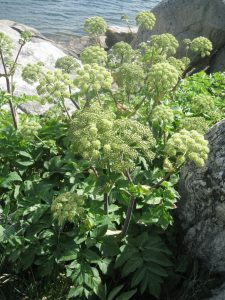I spent an hour today in a discussion with a group of MSc Gastronomy students from Queen Margaret University considering whether there is a distinctive Scottish cuisine. More on this later in the year as I prepare for my Cabaret of Dangerous Ideas act but meanwhile one of the things that prompted this dialogue was a splendid new book on ‘healthy Sami food culture’ by Greta Huuva. Greta is a cook, forager, herbalist, ecologist and proud tradition-bearer of the Sami people of Northern Scandinavia. A book and film, Nature is my Kitchen, in which she talks about her life, her culture, her philosophy, her restaurant business and her recipes have recently been produced by Varda, the talented publishing and film-making duo Veronica Bernacchioni and Andrea Barghi.
Italians living in the far north of Sweden, Veronica and Andrea have visited Edinburgh twice in recent years to introduce us to th
e landscape, wildlife and Sami culture of their adopted home. Now with their characteristically high production values they have created an astonishingly beautiful and truthful insight into a world that is both uncannily familiar and yet at the same time exotic. The habitat where Greta gathers herbs and edible plants, and that her family share with thousands of semi-domesticated reindeer, is similar to much of the Scottish Highlands and the midges that plague a summer foraging trip with her grandchildren are far too familiar. But the Sami goahti (a tipi-like tent), pine-bark bread baked over an open fire on a skillet, and chaga mushroom coffee are part of a Northern culture that has no parallel on our side of the North Sea.
There is a recipe section at the
back of the book, with a selection of favourite Sami dishes from Greta’s Jokkmokk café. I skipped the recipes for reindeer meat and blood dumplings and blood pancakes (I will try these I hope one day in Jokkmokk) and went straight to wild vegetables and fruit section. Cloudberry parfait, juobmo (a sauce made with wild sorrel), char cured in spruce shoots, lingonberry pudding and Greta’s summer salad sound and look delicious, and I am looking forward to experimenting with some Sami tastes in season.
Greta describes collecting and using numerous wild plants, including alpine bistort, alpine sow thistle, Labrador tea, roseroot and ten kinds of wild berry but she appears to have a special affection for wild angelica. She utilises the whole plant ‘the root for medicine, the stalk and leaves to sour milk, and the seeds as a spice … a piece of angelica root to chew on was
an excellent defence when you met strangers… it increases the immune system’. She describes a knowledge of healing plants as once being commonplace not confined to shaman and one of the delights of the Greta’s story is the way that she is instructing her own children and grandchildren in the old ways that have so much relevance today.
To order copies of the book and DVD visit Varda’s website http://vardahb.com/bookshop/ For Year of Food and Drink events including Dining on the Wildside visit the RBGE What’s On http://www.rbge.org.uk/whats-on/event-details/3782

